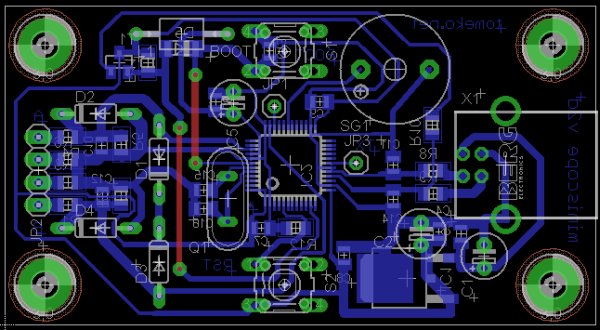Cheap low-speed dual channel PC/USB oscilloscope and arbitrary waveform generator with STM32F3 microcontroller.
Miniscope v2d is based on STM32F303CBT6 microcontroller – LQFP48 device from STM32F3 family featuring:
- 32 kB RAM on data bus
- 8 kB RAM on instruction bus
- 128 kB FLASH memory
- USB device (full speed)
- 4 fast and flexible ADCs
- 12-bit DAC with two output channels
- 4 opamps that can work in PGA mode
- ROM bootloader with USB DFU option available
STM32F303CBT6 is pin compatible with STM32F103C8T6 used in miniscope v2c and previously designed PCB could be reused. Still few changes were made to make better use of STM32F303. USB pull-up resistor can now be controlled by software and is also disconnected when device is in reset state to allow re-enumeration without physical disconnecting and more convenient switching between bootloader and user firmware (DFU is intended to be used to upload firmware).
As a side note: it looks like DFU is not working on similar STM32F37x microcontrollers (ebrombaugh.studionebula.com).
STM32F30x ADCs are significantly faster than in STM32F1 (7.2 MSPS in 8-bit mode), but practical sampling speed is limited because of lack of input buffer. Of course PGA would help with getting optimal combination of speed/precision, sensitivity and acceptable input impedance.STM32F303CBT6 is pin compatible with STM32F103C8T6 used in miniscope v2c and previously designed PCB could be reused. Still few changes were made to make better use of STM32F303. USB pull-up resistor can now be controlled by software and is also disconnected when device is in reset state to allow re-enumeration without physical disconnecting and more convenient switching between bootloader and user firmware (DFU is intended to be used to upload firmware).
As a side note: it looks like DFU is not working on similar STM32F37x microcontrollers (ebrombaugh.studionebula.com).
STM32F30x ADCs are significantly faster than in STM32F1 (7.2 MSPS in 8-bit mode), but practical sampling speed is limited because of lack of input buffer. Of course PGA would help with getting optimal combination of speed/precision, sensitivity and acceptable input impedance.
For more detail: Miniscope v2d

